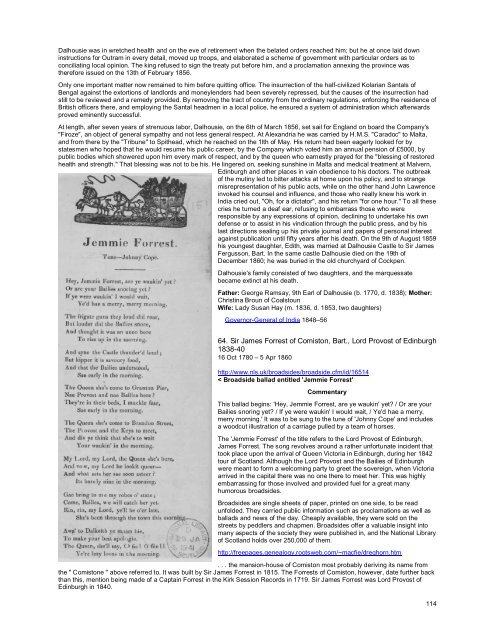Grand Masters of Scotland - Onondaga and Oswego Masonic ...
Grand Masters of Scotland - Onondaga and Oswego Masonic ...
Grand Masters of Scotland - Onondaga and Oswego Masonic ...
You also want an ePaper? Increase the reach of your titles
YUMPU automatically turns print PDFs into web optimized ePapers that Google loves.
Dalhousie was in wretched health <strong>and</strong> on the eve <strong>of</strong> retirement when the belated orders reached him; but he at once laid down<br />
instructions for Outram in every detail, moved up troops, <strong>and</strong> elaborated a scheme <strong>of</strong> government with particular orders as to<br />
conciliating local opinion. The king refused to sign the treaty put before him, <strong>and</strong> a proclamation annexing the province was<br />
therefore issued on the 13th <strong>of</strong> February 1856.<br />
Only one important matter now remained to him before quitting <strong>of</strong>fice. The insurrection <strong>of</strong> the half-civilized Kolarian Santals <strong>of</strong><br />
Bengal against the extortions <strong>of</strong> l<strong>and</strong>lords <strong>and</strong> moneylenders had been severely repressed, but the causes <strong>of</strong> the insurrection had<br />
still to be reviewed <strong>and</strong> a remedy provided. By removing the tract <strong>of</strong> country from the ordinary regulations, enforcing the residence <strong>of</strong><br />
British <strong>of</strong>ficers there, <strong>and</strong> employing the Santal headmen in a local police, he ensured a system <strong>of</strong> administration which afterwards<br />
proved eminently successful.<br />
At length, after seven years <strong>of</strong> strenuous labor, Dalhousie, on the 6th <strong>of</strong> March 1856, set sail for Engl<strong>and</strong> on board the Company's<br />
"Firoze", an object <strong>of</strong> general sympathy <strong>and</strong> not less general respect. At Alex<strong>and</strong>ria he was carried by H.M.S. "Caradoc" to Malta,<br />
<strong>and</strong> from there by the "Tribune" to Spithead, which he reached on the 1lth <strong>of</strong> May. His return had been eagerly looked for by<br />
statesmen who hoped that he would resume his public career, by the Company which voted him an annual pension <strong>of</strong> £5000, by<br />
public bodies which showered upon him every mark <strong>of</strong> respect, <strong>and</strong> by the queen who earnestly prayed for the "blessing <strong>of</strong> restored<br />
health <strong>and</strong> strength." That blessing was not to be his. He lingered on, seeking sunshine in Malta <strong>and</strong> medical treatment at Malvern,<br />
Edinburgh <strong>and</strong> other places in vain obedience to his doctors. The outbreak<br />
<strong>of</strong> the mutiny led to bitter attacks at home upon his policy, <strong>and</strong> to strange<br />
misrepresentation <strong>of</strong> his public acts, while on the other h<strong>and</strong> John Lawrence<br />
invoked his counsel <strong>and</strong> influence, <strong>and</strong> those who really knew his work in<br />
India cried out, "Oh, for a dictator", <strong>and</strong> his return "for one hour." To all these<br />
cries he turned a deaf ear, refusing to embarrass those who were<br />
responsible by any expressions <strong>of</strong> opinion, declining to undertake his own<br />
defense or to assist in his vindication through the public press, <strong>and</strong> by his<br />
last directions sealing up his private journal <strong>and</strong> papers <strong>of</strong> personal interest<br />
against publication until fifty years after his death. On the 9th <strong>of</strong> August 1859<br />
his youngest daughter, Edith, was married at Dalhousie Castle to Sir James<br />
Fergusson, Bart. In the same castle Dalhousie died on the 19th <strong>of</strong><br />
December 1860; he was buried in the old churchyard <strong>of</strong> Cockpen.<br />
Dalhousie's family consisted <strong>of</strong> two daughters, <strong>and</strong> the marquessate<br />
became extinct at his death.<br />
Father: George Ramsay, 9th Earl <strong>of</strong> Dalhousie (b. 1770, d. 1838); Mother:<br />
Christina Broun <strong>of</strong> Coalstoun<br />
Wife: Lady Susan Hay (m. 1836, d. 1853, two daughters)<br />
Governor-General <strong>of</strong> India 1848–56<br />
64. Sir James Forrest <strong>of</strong> Comiston, Bart., Lord Provost <strong>of</strong> Edinburgh<br />
1838-40<br />
16 Oct 1780 – 5 Apr 1860<br />
http://www.nls.uk/broadsides/broadside.cfm/id/16514<br />
< Broadside ballad entitled 'Jemmie Forrest'<br />
Commentary<br />
This ballad begins: 'Hey, Jemmie Forrest, are ye waukin' yet? / Or are your<br />
Bailies snoring yet? / If ye were waukin' I would wait, / Ye'd hae a merry,<br />
merry morning.' It was to be sung to the tune <strong>of</strong> 'Johnny Cope' <strong>and</strong> includes<br />
a woodcut illustration <strong>of</strong> a carriage pulled by a team <strong>of</strong> horses.<br />
The 'Jemmie Forrest' <strong>of</strong> the title refers to the Lord Provost <strong>of</strong> Edinburgh,<br />
James Forrest. The song revolves around a rather unfortunate incident that<br />
took place upon the arrival <strong>of</strong> Queen Victoria in Edinburgh, during her 1842<br />
tour <strong>of</strong> <strong>Scotl<strong>and</strong></strong>. Although the Lord Provost <strong>and</strong> the Bailies <strong>of</strong> Edinburgh<br />
were meant to form a welcoming party to greet the sovereign, when Victoria<br />
arrived in the capital there was no one there to meet her. This was highly<br />
embarrassing for those involved <strong>and</strong> provided fuel for a great many<br />
humorous broadsides.<br />
Broadsides are single sheets <strong>of</strong> paper, printed on one side, to be read<br />
unfolded. They carried public information such as proclamations as well as<br />
ballads <strong>and</strong> news <strong>of</strong> the day. Cheaply available, they were sold on the<br />
streets by peddlers <strong>and</strong> chapmen. Broadsides <strong>of</strong>fer a valuable insight into<br />
many aspects <strong>of</strong> the society they were published in, <strong>and</strong> the National Library<br />
<strong>of</strong> <strong>Scotl<strong>and</strong></strong> holds over 250,000 <strong>of</strong> them.<br />
http://freepages.genealogy.rootsweb.com/~macfie/dreghorn.htm<br />
. . . the mansion-house <strong>of</strong> Comiston most probably deriving its name from<br />
the " Comistone " above referred to. It was built by Sir James Forrest in 1815. The Forrests <strong>of</strong> Comiston, however, date further back<br />
than this, mention being made <strong>of</strong> a Captain Forrest in the Kirk Session Records in 1719. Sir James Forrest was Lord Provost <strong>of</strong><br />
Edinburgh in 1840.<br />
114







![Richard [Nicholls] Harison / Harrison - Onondaga and Oswego ...](https://img.yumpu.com/24950065/1/190x245/richard-nicholls-harison-harrison-onondaga-and-oswego-.jpg?quality=85)
![Richard [Nicholls] Harison / Harrison - Onondaga and Oswego ...](https://img.yumpu.com/24950063/1/190x245/richard-nicholls-harison-harrison-onondaga-and-oswego-.jpg?quality=85)








